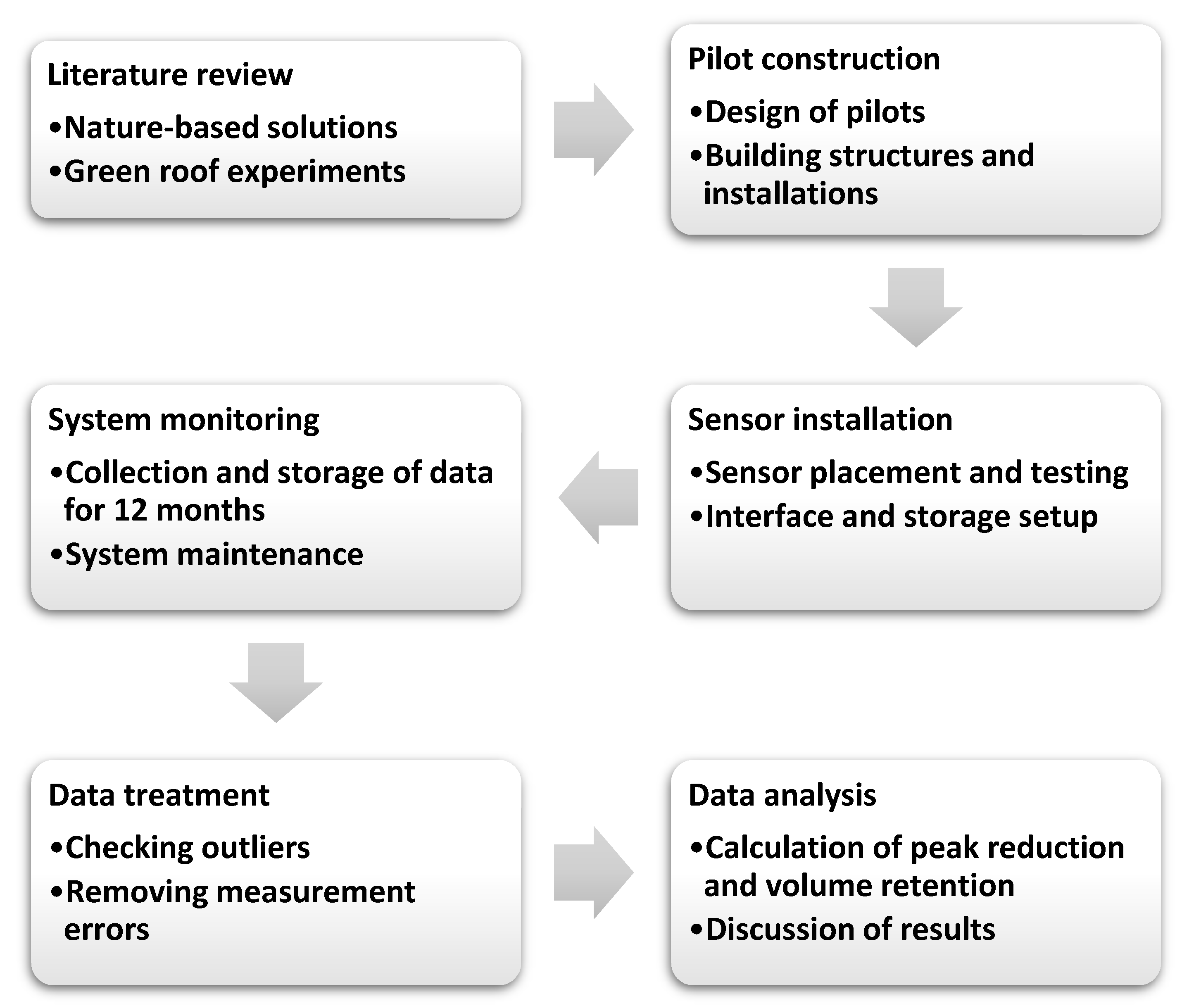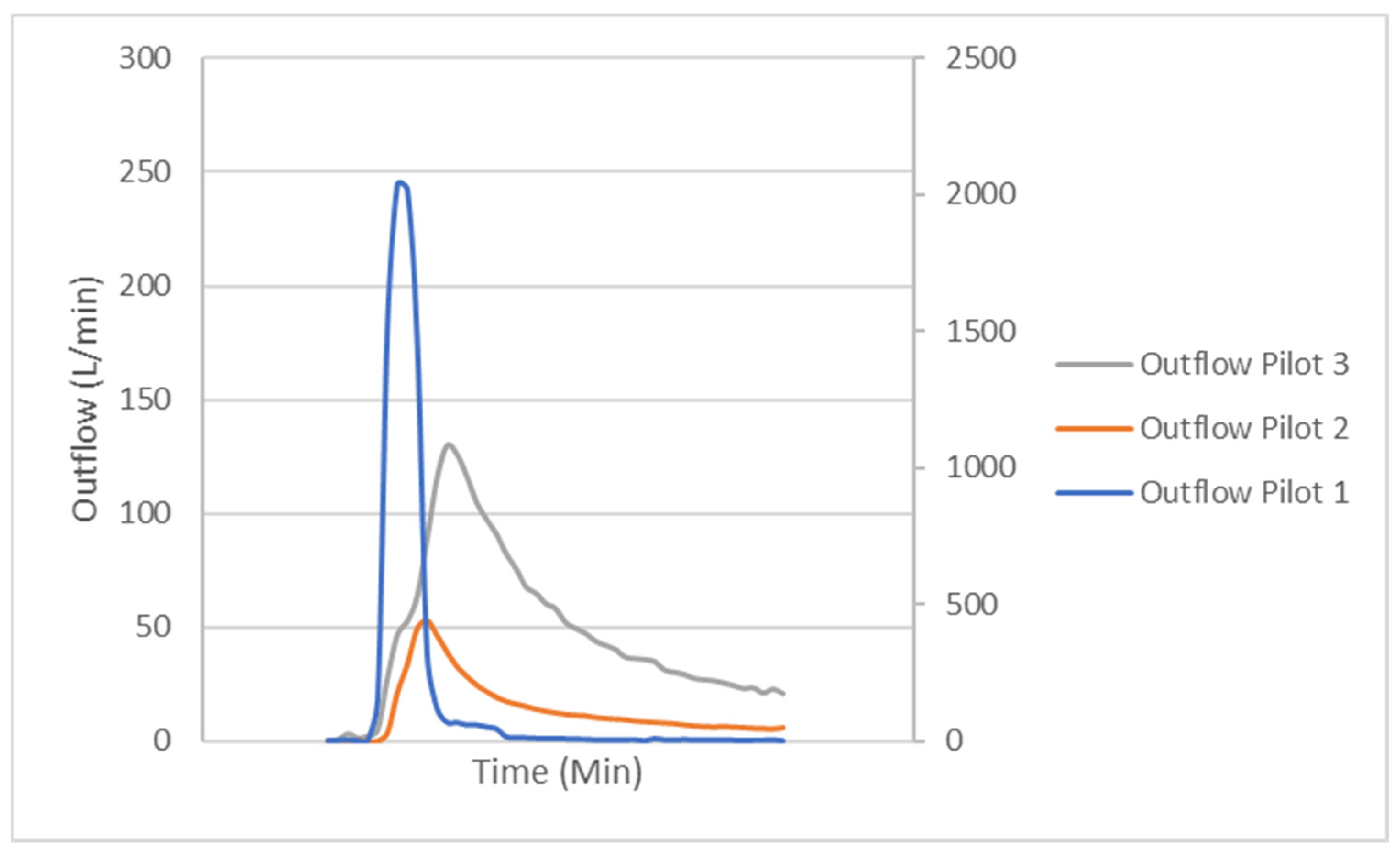1. Introduction
Nature-based solutions (NbSs) can be defined as actions used to protect and restore natural or modified ecosystems, helping to mitigate social challenges based on an adaptative approach using natural or inspired nature processes, which are beneficial at the same time to human well-being and biodiversity [
1]. Rain gardens [
2], constructed wetlands [
3], green walls [
4], and green roofs [
5] are just some examples of the large variety of NbSs currently available as mature technologies for rainwater management.
Green roofs, particularly, provide not only benefits to rainwater management but also contribute to attenuating the heat island effect, extending roof life, reducing carbon emissions, enhancing air quality, creating recreational spaces, and creating sound insulation [
6,
7,
8,
9]. In addition, green roofs are one of the nature-based technologies most largely used in the construction sector.
According to [
10], in the context of sustainable urban development and climate change, green roofs arise as a promising technology to address the adverse impacts of urbanization. Indeed, beyond their aesthetic benefits, this technology can also be considered a decentralized solution for climate adaptation and flood mitigation [
11] since it can contribute to a reduction in and delay of the peak flow in rainwater systems. However, even if it can be considered a mature technology, there are no consolidated design standards or guidelines particularly describing how to estimate rainwater volume retention in green roofs at national and international levels. Indeed, there is no specific protocol defined to estimate green roofs’ retention capacity [
12], and an absence of standardization in the procedures used to collect and analyze data on green roof hydraulic behavior [
13]. It is important to note that in order to establish such protocols, it is important to consider design differences, which depend on both green roofs’ physical configurations and local climate characteristics [
14]. So, the goal of this study is to analyze the hydraulic effect of green roofs on rainwater management based on experimental outflow rate monitoring. This paper aims to support research advancements towards the definition of green roofs’ hydraulic performance benchmark, using a simple experimental protocol for the hydraulic analysis of peak flow and volume retention and providing experimental data to support the definition of benchmarks for Nordic countries.
2. Material and Methods
2.1. Methodological Framework
Figure 1 presents the methodological steps adopted during the project. First of all, a literature review was carried out addressing the technical aspects and experimental analysis of green roofs. After the pilot was designed and built, flow meters were installed together with the monitoring network to enable data access. Then, the system was monitored over 12 months, followed by data treatment in order to remove measurement errors, and finally, a statistical analysis was performed.
2.2. Description of the Experimental Apparatus
The experimental setup was installed at Ballerup in Denmark at the DTU campus. The system consisted of 3 pitched roofs, each one with 25 m
2 of surface area. Pilot 1 is a conventional roof covered with asphalt rolling, used as a reference roof. Pilot 2 presents a green roof made of a 40 mm continuous substrate, and Pilot 3 represents a green roof made of plastic pack modules with a total thickness of 60 mm. These two configurations were chosen because they have distinct physical characteristics and represent common green roofs that are commercially available in Nordic countries.
Figure 2 presents a photo of the three roof pilots used in the experiments.
Moreover, in each pilot, an insulated wooden box was used to encapsulate the flow meter in order to protect the device against freezing during winter, as can be seen in
Figure 2. To avoid water freezing in the pipes, a heating probe was also inserted into the outlet pipe.
2.3. Hydraulic Measurements and Monitoring
The green roofs were monitored for 12 months, from January to December 2019.
Meteorological data were monitored using a weather station located just on the side of the pilots. The water retention in the green roofs was monitored by measuring the rainwater flow rate in the outflow pipe that collects water in each roof. The water from each pilot roof was collected by a gutter and sent to a downspout pipe, which was connected to a magnetic flow meter Yokogawa® AXFA14.
Concerning data management and storage, data from the flow meters were updated every 10 s and sent to a datalogger connected to a computer in which data were stored. The database can be accessed remotely using the software Dim.Score® version 10.0.1.126 from DHI®, which enabled us to treat and visualize the monitored data.
In terms of monitoring, Pilot 1 (conventional roof) was used as a baseline of outflow to be compared with the amount of rainwater retained in the 2 green roofs (Pilot 2 and 3). The 2 types of green roofs were compared in terms of rainwater retention as well as peak flow attenuation. Rainwater volume retention was estimated by the mass flow balance comparing the rainfall precipitation with the outflow volume from each roof over the year.
Data treatment consisted of checking for measurement errors, e.g., signal errors recorded by the sensor, and excluding from the analysis dates with missing data due to sensor malfunctioning. Peak flow attenuation, in turn, was determined by comparing the max outlet flow measured from Pilot 1 with the max outflow from Pilots 2 and 3. The monitored data were analyzed with the support of graphical visualization. In addition, descriptive statistics of the flow measurements were used to compare the hydrologic patterns of both green roofs.
3. Results and Discussion
Table 1 provides a summary of the descriptive statistics obtained for attenuation peak flow during the monitored period for the green roofs analyzed.
In terms of peak flow attenuation, average values of 55% and 39% were obtained for Pilots 2 and 3, respectively, but high variation was noted in both pilots, ranging from about 10% up to 90%, depending on rain intensity, the occurrence of successive rain events, and the duration of dry periods. As this high variation was observed in both pilots and provided that it is highly related to seasonal differences, it is important to outline the fact that safety factors are essential when estimating peak flow attenuation. Indeed, due to the high variability, it is recommended to consider the specificities of seasonal average rainfalls in order to carry out a more accurate estimation of the potential of green roof use for peak flow attenuation.
Furthermore,
Figure 3 shows the peak flow over time for the three pilots for a rainfall event that occurred on 12th September 2019. It is possible to note from
Figure 3 how different the peak flow attenuation can be from one pilot to another, as well as in terms of peak delay. Therefore, the huge variation observed is highlighted here again. Indeed, even if, on average, the peak flow attenuation was similar for both green roof pilots, sometimes they resulted in different peak flow attenuation, as shown in this event presented in
Figure 3, which corroborates the high variability identified in the statistics analysis.
In terms of water volume retention, over the monitoring period, the green roofs presented variations in rainwater retention capacity, ranging from about 20% to 50%. The variations over the year are likely related to differences in the rain distribution over the year, as well as other weather conditions, such as temperature, solar radiation, and evaporation. In terms of the differences between pilots, the average annual rainwater retention capacity for the monitored period obtained for Pilots 2 and 3 were 43% and 18%, respectively.
These differences in peak flow and volume retention capacity are likely related to the physical characteristics of the tested green roofs. Pilot 2 presented higher values for both variables, probably due to the fact that it has a continuous substrate that can act as a retention bed. In contrast, Pilot 3 is made of discrete plastic pack modules, which can be more limited in terms of their available volume for storage. The hydraulic performance can also be affected by the properties of the materials used, such as the substrate in each tested green roof. Indeed, this can directly affect hydraulic conductivity and consequently impact the aforementioned hydraulic parameters.
This variation between green roof types was already expected because they present different physical characteristics and are made of different materials; it was expected that they would provide different results in terms of the volume of rainfall they were able to retain. Actually, the significant difference observed in this parameter is another aspect that must be considered during the selection of green roof models. Green roof types must be selected depending on the demand for rainwater retention in conjunction with other relevant benefits expected from the green roof (heat island attenuation, aesthetic impact, etc.). As green roofs have multiple benefits to the built environment, accurately identifying and characterizing the hydraulic differences between the available green roof types is an important task to support decision-making in order to better select the solution that fits a particular context in which multiple criteria must be considered.
It is important to highlight that these observations of hydraulic behavior in green roofs can be crucial from the point of view of urban planning. The variability in green roof peak flow reduction and volume retention can have practical implications because it is essential to consider differences in green roof performance in order to better estimate the potential of their use in flood prevention and to avoid overestimations in peak flow reductions.
4. Conclusions
This study aimed to carry out an experimental analysis of green roofs in terms of hydraulic patterns in order to contribute to the advancement of knowledge related to this technology. The experiments performed were able to provide valuable information in terms of the operation of the system, providing an insightful overview of the hydrological contribution of green roofs as an NbS technology that enables rainwater management enhancement. The results obtained show the potential rainwater retention capacity of green roofs and outline quantitatively the differences between green roof types in terms of peak flow retention. These findings can be used to support future studies addressing design optimization, the creation of international design, and maintenance guidelines, as well as supporting a more accurate analysis of green roofs as a solution in urban planning to support flood prevention.
In future studies, it is recommended to continue using the monitoring system in order to assess the variation in the performance of the green roofs over time in a way that is possible to understand how the system capabilities can vary from newly implemented to older systems.









